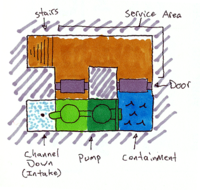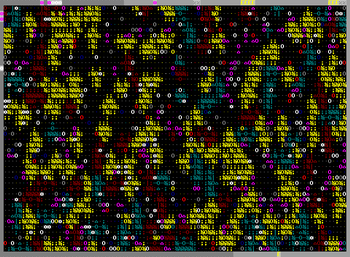Tree farming
| Эта статья нуждается в переработке. Причина: Требуется перевод |
| Часть ряда статей о |
| Проектах |
|---|
| Основные |
| Акведук • Башня лучников • Атомный дезинтегратор • Опасная комната • Дамба • Свалка • Массовый сброс • Ров • Яма-ловушка • Резервуар• Ворота для вылазок • Плавательный бассейн • Башня • Ферма деревьев |
| Продвинутые |
| Топильная камера • Магменный поршень • Обсидиановая ферма • Ряд винтовых насосов • Шёлковая ферма • Водяной реактор |
Ферма деревьев — это процесс создания и управления окружающей средой, в которой молодые деревья будут безопасно расти и становиться созревшими деревьями. В настоящее время посадка деревьев невозможна без модов, однако можно использовать иные способы. Эта ферма может использоваться в древесной индустрии или создания сада с ценными растениями. Фермы деревьев должны быть в умеренной местности; так как деревья очень долго растут, для многих нетерпеливых игроков это станет проблемой.
Метод
Создание фермы деревьев, как правило, не сложное, но всё зависит от ситуации и потребностей. Ферма должна быть высотой не менее двух уровней (хотя, чем больше будет уровней высоты, тем больше будет урожайность) с почвой или загрязнённым каменным полом. Огораживание (и с опциональной крышей) внешней области может быть достаточно, но крупные проекты могут быть и под землёй. Подземные растения (включая деревья) будут расти после того, как пещера будет обнаружена.
Наземная ферма
Огораживание соответствующего участка может обеспечить безопасный сбор растений и рубку деревьев, даже во время осады. Крыша может обеспечить полную безопасность от лазания и летающих врагов, однако, высокая стена из блоков может обеспечить безопасность. Если вы высадились в лесистой долине, то можно снизить трудовые затраты, включив её в свой дизайн.
Ферма на верхнем слое почвы
Если вы высадились в области, где есть как минимум два слоя почвы, вы можете выкопать вглубь нужную вам площадь и после на поверхности заделать крышей. Наземные деревья вырастут на тайлах, помеченные как "Освещенные внутри", тем самым давая создать внутренний сад или ферму деревьев.
Ферма на подземной почве
If your embark has at least three soil layers, the fastest way to create an underground tree farm is by channeling out two or more subterranean soil layers while leaving the bottom soil floor intact. Since soil is easily mined and requires no irrigation this is probably the easiest option if available. Note, however, that your farm might experience "light leakage" and "branch collapse" problems if you mine out the layer directly below the surface.
Ферма в пещере
If you find a suitably-sized muddy cavern you can opt to just use that as a tree farm. Walling it off provides safety against migrating "wildlife". Existing caverns can be enlarged by channeling out layers above the soil, but any horizontal expansion will need to be irrigated. Note: causing a cave-in to clear overhanging stone will damage the mud floors, requiring re-irrigation.
Ферма в глубинах подземелий
If the above options are not for you then your next option is to dig out a large underground space, haul out the waste rock, and flood it. Locate several suitable levels and set your miners to work. While your miners and haulers are hard at work set up an irrigation system. Large amounts of water will need to be utilized since evaporation is a significant force when dealing with liquid spread thin over open areas. Aquifers, rivers, and underground lakes make excellent sources, but be wary of slowing frame rates especially with lakes. Once every tile has been covered then you can opt to recycle the water by dropping it down onto a similarly opened out space on a lower level. This way you may dig out larger farms without requiring more water.
Use and production
Freshly watered or sporulated farms will require about three years of growing before trees reach minimal harvest size. In this time a few may show up early, but the majority will mature as a group within the span of a month of in-game time. After the first group of trees appear, trees will show up slightly more frequently and steadily as time progresses.
Certain trees (especially underground -caps) produce only one or two logs, even when fully grown. For optimum yield, those trees should be harvested as soon as they reach minimum size. Other more productive trees (blood thorns, fungiwood, and spore trees) can be allowed to continue growing for much larger returns.
Your tree farm can be specialized into an orchard indirectly, by allowing desired trees to continue growing and cutting down any undesired trees. Note that there is an upper limit to the number of same-species trees that will grow in an area; specializing on two or more species is recommended for optimum production.
Tree farms can double as pastures, but trampling may lead to lowered wood production in the area occupied by grazers. It is generally advisable to create separate pasture and tree farming areas since pastures do not require multiple z-levels of open space.
Details
Trees will not grow on soil that is occupied by rocky boulders, items, buildings or stockpiles. Removal of these obstructions will increase the productive area of your farm.
Saplings of underground trees will not form in artificial areas until a cavern has been breached. Underground saplings will die if marked as Outside.
A sapling must fulfill a few requirements in relation to the environment in order to mature. Saplings will not mature if there are many others of the same species in the area around it. On top of this, surface trees must meet a certain density requirement based on the biome your fortress is in. If there are too many mature trees in an area then growth will be halted. Underground trees always grow with uniform density.
Harvested trees sometimes remove mud from their growth tile. For long-term sustainable production non-soil tree farms will need occasional irrigation.Bug:9951
Large tree farms can have a ridiculous impact on framerates, particularly when displayed on-screen.Bug:8877 Multi-tile trees produce much more wood than their single-tile counterparts, so a gigantic tree farm probably isn't necessary. It may be best to create multiple small tree farms (on separate levels) as your fortress's needs increase instead of one megaproject farm.

